Feature Interview with Tom Doak
August 2001
1. How did you work together with your co-authors on the MacKenzie book?
Actually, I still haven’t met James Scott. Dr. Scott had already written the basis of a manuscript before I got involved with the project. He had done all the research on MacKenzie’s life story, and collected correspondence and notes from the minute bookson MacKenzie’s exploits in England and in Australia.
But he didn’t have the background in golf course design to explain what was different and special about MacKenzie’s designs, so Brian Lewis asked me to contribute a couple of chapters on MacKenzie’s best courses. It didn’t flow that way; so eventually I wound up rewriting the book, keeping a lot of Dr. Scott’s words but interweaving my own commentaries on the Doctor’s style.
Ray Haddock contributed a few of the sidebar stories.
2. What surprised you the most in researching the book?
Most people will be shocked how little time Dr. MacKenzie spent on some of his most famous projects, but I already had a good idea of that. I was shocked to find out just how closely my own tastes follow MacKenzie’s. For example, on the West course at Royal Melbourne, I have always been most impressed by the stretch of holes 3-10, and then 17 and 18. As it turns out, those are the only holes MacKenzie routed from scratch; the rest are adaptations of holes off the original Royal Melbourne layout, with the tees repositioned and bunkers added by MacKenzie. But his original holes are all the holes I like the best.
3. What are the standout design features of MacKenzie’s work around Leeds?
Apart from Alwoodley and Moortown, there are quite a few excellent small courses that he built close to home, and one assumes he spent a bit more time with these because they were easily observed. The Doctor rebuilt a few holes at Headingley Golf Club, just a couple of miles from Alwoodley, and its 16th and 17th greens are a couple of his earliest radical creations. Halifax Golf Club, about twenty miles west, is a wonderful routing. Even on his earliest designs, he made the most of the boldest features on a site. Interestingly, though, the bunkering on those courses isn’t very spectacular; he was probably still learning how to build beautiful features.
4. How much influence did Harry Colt have on Dr. MacKenzie’s style?
I don’t think anyone influenced MacKenzie’s design ideas all that much. Colt only made the one visit during the design and construction of Alwoodley, and by the time they became partners, MacKenzie’s philosophy was already fully formed. Anyway, as partners, they rarely got together because they were both busy with their own workload.
The one place they might have spent time together was on the Eden Course at St. Andrews. MacKenzie goes to great lengths in his writings to give full credit to Colt for its design, but some of its greens are so wild that I feel sure that they reflect MacKenzie’s influence. That would also explain how MacKenzie became so familiar with The Old Course before he wrote his book in 1920. Unfortunately, the documentation of MacKenzie’s influence wasn’t there; his unusual modesty in the matter was what attracted my attention.
5. Which of MacKenzie’s courses play most as he intended them to?
In the U.S., I think Cypress Point and The Valley Club still play as they were meant to. Crystal Downs may be even better preserved, but with the greens speeds as fast as they are today, I’m sure it plays more severely than MacKenzie intended. Overseas, I’d say Royal Melbourne (West) and The Jockey Club are just what the Doctor ordered. In the U.K., the little courses like Cavendish and Halifax seem to be better preserved than his more famous tests; Alwoodley still isn’t far off base.

The approach to the 3rd at The Valley Club.
6. If Augusta National brought you in to consult, what would you suggest to them?
That’s not going to happen; Augusta puts The Masters ahead of MacKenzie on its priority list. Actually, though there have been innumberable changes to the course, I don’t think that many of them are in conflict with MacKenzie’s ideals. I don’t believe restoring the original seventh green or tenth green or sixteenth hole would make it a better course. The swale at the 13th is probably the most incongruous feature out there. That old boomerang green at the ninth might have been interesting, too.
7. How much influence did Pete Dye have on your own style?
The style I’ve established for myself is very different than Pete’s, on purpose; I figured if someone wanted a ‘Pete Dye course’ they’d go to his sons. And by the time I started working for Pete, I’d already seen so many great courses in so many different styles, I didn’t think his way was the only way. What I learned from Pete and Alice was that construction is inseparable from design, and that you have to take charge of your projects in the field to be sure that you get everything you want into them. And I learned most of what I know about golf course construction by working for the Dyes. I can’t imagine how I would have learned to design in 3-D, if it wasn’t for them.
8. What are the best courses you’ve seen since The Confidential Guide was published five years ago? What ratings would you give those courses on the Doak Scale?
I’ll have to separate that question into three categories. I’ve only seen a couple of courses which I would give an 8 on the Doak scale — Bandon Dunes and Kingsbarns. I’ve seen 15 or 20 which would rate a 7 or even 7-1/2. Among them are Wild Horse, Talking Stick (North), Lehigh CC, Caledonia, Cuscowilla, The Challenge at Manele, Loch Lomond, Portstewart, Hamburger GC [Falkenstein, Germany], the Moonah Course at The National in Australia, and Nantucket Golf Club. Not too many surprises there.
I get more genuine fun out of stumbling upon an undiscovered gem, even though I may rate them a bit lower than you’d like when it comes time to put a number on them. The most excited I’ve been in five years was my first and only trip around Brora; I don’t know how I missed that one when I lived overseas.
Other ‘hidden gems’ are Plymouth [Mass.] CC, Oakhurst Links in W.V., John’s Island West, Barrington Hills, Gullane #3, Halifax GC in England, and Woodlands GC in the Sand Belt.
We’ve also opened seven new courses since the book came out, and I’m proud to say nearly all of them rank right up there with the courses mentioned above — though I’m grateful I don’t have to put my numbers for them in print right now. Will I give Pacific Dunes a 10? It’s damned close.
9. Were you pleased with the response to your Archipalooza get-together in Oregon in March? What were your goals for it?
Archipalooza was also my 40th birthday party, and I’ve never had more fun on my birthday than getting together with a bunch of guys I respect and playing Pacific Dunes. I think everyone there was awakened to how many talented people there are in this business, and it was nice to find out that the new generation of architects is interested in what the others are doing. However, I must admit we were pretty badly organized as far as creating a format for the group to share ideas. Brian Silva has made some great suggestions in that regard. Next time we get together, we’ll be more prepared.
10. Describe one of your favorite holes at Pacific Dunes, with particular attention to some of the subtleties which the one-time visitor may miss.
From day one, one of my favorite holes at Pacific Dunes has been number two, which is just short of 370 yards. In the summer wind, it’s a really difficult four. The wind is usually a bit right-to-left off the tee as well as in your face, so it’s hard to hit a faded tee shot far enough to carry past the ‘Shoe’ bunker in the middle of the fairway, and a draw gets swept toward the bigger bunker on the left. If you drive into the ‘Shoe,’ it’s a wedge out and a tough five; if you land on the upslope, it’s really easy to hook the second shot way left of the green, with the wind helping again. So maybe it’s better to play the tee shot short and left, giving yourself a flat lie for a longish second shot.
When it’s downwind, you ought to be able to carry the bunkers, and the correct line is right over the ‘Shoe,’ so the ball will roll on down into the hollow on the left past the bunkers. If you play to the right of it, you’ll have a tougher stance, and you’ll have a harder time stopping the second shot once it carries the bunkers.
On the approach, you can’t see that if you carry the bunkers on the right front of the green, nearly everything bounces down onto the putting surface. That helps make up for the crosswind and for the trouble in front. If people would just take an extra club or two for the second shot, they’d make a lot more fours there.
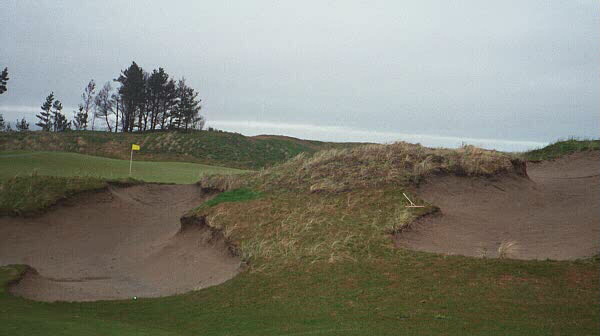
A ball that carries just over these bunkers bounces onto the 2nd green at Pacific Dunes.
11. Which three holes you’ve built would you most like to change? What would you change about them?
I hate the 18th at High Pointe, but most of the problems there are caused by wetlands so it can’t really be fixed the way it should — to make the landing area for the tee shot less of a carry for the average player, and give more room for the good player to hit a driver.
I also wish we could soften the bite of the wetlands on the 5th at Stonewall — the tee shot and green complex make it one of my best par-3’s, but there’s nowhere to drop if you don’t make the carry. Again, though, my hands are sort of tied on fixing it.
And I might rebuild the greens on the second and third holes at Black Forest. That could have been a great course, but it’s a bit over the top, and those two greens are probably the worst offenders. Once started, though, it would be hard to decide where to stop. I’d have to do them all again, really.
I know a lot of people wish I’d blow up the fourth green at Lost Dunes, but I think that’s a great hole just the way it is. Severe, yes, but really fun to play.
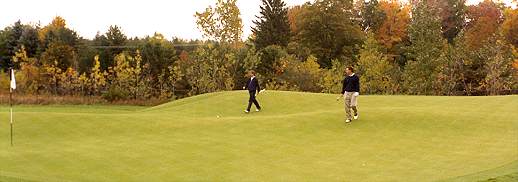
Doak chases after a putt on the wild 4th green at Lost Dunes.
12. Pacific Dunes has received nothing but glowing reports since its debut.Like Dr. MacKenzie at Cypress Point, are you a bit surprised or disappointed that it hasn’t generated more debate?
Actually, it’s nice to be above ‘controversy’ for a change. [I’m pretty sick of being described with that word. I’m really not nearly as much of an asshole as I am portrayed as being.] Anyway, Pacific Dunes may not be perfect, but just like Cypress Point, when a hole treats you badly, it’s such a beautiful place that it’s hard to hold a grudge. I am concerned that the praise has been so overwhelming that people who haven’t seen it will just want to play Devil’s Advocate. It doesn’t need a bandwagon — the course will stand on its own merits.
13. How would you compare Pacific Dunes to Sand Hills architecturally?
I think Pacific Dunes has a couple more knock-your-socks-off holes than Sand Hills does, just because they’re right along the Pacific Ocean. Philosophically, though, I think they are sisters. I’d like to think that I would have designed the same course at Sand Hills that Bill and Ben did; and I’d like to believe they would have made most of the same decisions I did at Pacific Dunes.
14. How much different would the design of Pacific Dunes be if it were a private course, instead of a high-end resort?
I don’t think the design would be much different at all. The course reflects Mike’s sensibilities as much as my own, and we both believe a course has to be playable. Public or private, it had to be as wide as it is because of the winds. If it had been private we might have considered holes with a blind tee shot, but neither of us is so enamored with blind holes that we would have tried hard to include one. And we didn’t have to make any of the normal concessions to cart paths in the design, which is one of the biggest obstacles most resort courses face.
If anything, the bunkering and grassing might have been even more rugged than they are. With traffic and the summer weather in Bandon, those ragged edges they have at Sand Hills [or used to have at Cypress Point] are in danger of serious wind erosion, so we have to keep the edges green to protect them.
Perhaps it’s better to say that if the course were private, it wouldn’t evolve as much as Pacific Dunes probably will to accommodate traffic concerns.
15. The back nine at Pacific Dunes is unconventional in that it only has two par fours. How hard was it for you to become convinced that this sequencing of holes was indeed the best routing for the property?
We knew the day we walked it that the routing was terrific, better than anything we’d come up with before. I did have reservations that it would be ‘acceptable,’ because the mix of holes on the back nine is unique. Anytime I’ve wanted to build an unusual sequence of holes, I’ve been able to come up with other great courses which had the same sequence, but there aren’t any other top-100 courses with four short holes and three par-5’s on one nine.
Mike Keiser surprised me on that. He had been concerned about an earlier routing that was par 34-37, but the final routing didn’t phase him at all, because we had walked it before we did the scorecard, and everyone loved it on the ground. I was less sure than Mike was, but I knew we could re-number the holes to something more conventional if necessary. Fortunately, we’ve never had to consider it. No one I’ve played with has ever remarked on the four short holes on the back side. By the time they leave the fourth green, they’re taking each hole as it comes.
16. What impact do you think Pacific Dunes will have on your firm’s business?
Everyone who’s seen the course thinks it will put us right at the top of the business. That would be great, but I don’t really expect it to happen that way, any more than David Kidd went to the top with Bandon Dunes. The business is still name-driven, and we’ll have to build 50 great courses before our names have the same recognition as Davis Love 3d. But we’ve been trying to establish ourselves as one of the leading firms in a small niche — knowledgable clients with great property — and I hope Pacific Dunes will put us closer to the head of that class.
17. What are your current projects?
We’ve signed up four new jobs to keep us busy over the next 18 months.
They’re all quite different projects, and a huge contrast from Pacific Dunes.
The first to start will probably be the 18 holes for Texas Tech University in Lubbock. It’s a dead-flat site right next to the campus, but a generous donor is giving us an ample budget to remake the landscape into something interesting. Right on the heels of Pacific Dunes, probably any site we took on was going to be a letdown, so we might as well go back to square one and show what we can do creatively. It’s the sort of challenge we need to have every once in a while. They want it to be ‘the best university course in America,’ and we’re taking them seriously. We will probably move about 700,000 cubic yards of earth to breathe life into the ground. I think we could do an interesting course with only half that much, but to achieve their goal I believe we have to make a bigger visual impression than just making 18 interesting golf holes.
We’ve also signed up to do the third 18 holes at Cabo del Sol in Mexico, as co-designers with Mark Parsinen, who developed Kingsbarns. This is a different league for us, following up behind Jack Nicklaus and Tom Weiskopf, who is just finishing the second 18 there. Of course no one expects us to challenge the Nicklaus course, which is rated among the top 100 in the world, since he’s been quoted as saying it’s the best site he’s ever had, with five holes right on the ocean. Ours will be across the road from the original ocean course, on the side of a steep hill — there’s more than 250 feet of elevation change from high point to low. But the views are unbelievable. You can see Los Arcos at the tip of the Peninsula, and around 15 miles of shoreline from west to east. We hope it will be a really different experience, but a course that everyone will want to play while they’re in town.
We’ve been working on the development of a second 18 holes at Stonewall for several years, and it looks like we might finally get started on that one in the spring. They only play 12,000 rounds on the original course, so it’s shocking that they want another 18, but a lot of the rationale for building this course is to protect the first one — to buffer the land from development, and to provide an alternative for members to use golf carts so as to keep the original course cart-free. The topography for the second course is a lot like the first, except there’s nothing like the stream valley on holes 4-7; but the views from the course are quite different than the original. We love the idea of working around Philadelphia again, and it will be a challenge to build something which complements the original 18 — but if we didn’t think this one could be as good, we wouldn’t be taking it on.
Last but not least, I’ve just gotten back from Australia, where we may build 18 holes at a place called Barnbougle Dunes, on the northern coast of Tasmania. That’s how far you have to go to get great land these days.
18. Describe the property at Barnbougle Dunes.
The land is as exciting as Pacific Dunes. Two miles of beachfront, with dunes up to fifty feet high. It’s not up on a cliff, but on one nine the dunes along the beach are relatively small, so there will be great views of the water. On the other nine, you get into the bigger and more dramatic dunes, but most of the holes are confined to the valleys, so you only get a water view from an occasional elevated tee. The only area where it doesn’t measure up to Pacific Dunes is the vegetation — the trees and gorse bushes gave Pacific Dunes beautiful contrast.
Oh, and the funding’s not in place yet! Pacific Dunes was relatively inexpensive to build, but it was nice to know we never had to worry about money if we wanted to move a bit of dirt. Barnbougle Dunes isn’t guaranteed to happen yet, and if it does, it will have to be built on a shoestring.
19. Haven’t you pursued other projects in Australia?
I’ve always wanted to do work in Australia, and between my love of MacKenzie and the success of The Confidential Guide there, we’ve had several inquiries before. We tried to get one of the new 18 holes at The National Golf Club, but lost out to Greg Norman and Peter Thomson, who are hard to beat at home. Then we did sign a contract to do 27 holes on a site very near The National — The Golf Club at St. Andrews Beach — but the original developer was ousted by his investment group, and now it looks like Thomson is going to do 36 holes on that site. Hopefully we’ll get our turn in Melbourne someday, and we’ll have a little extra incentive when we do. The bottom line is, it’s difficult to pursue overseas work. The minute we leave the country there are other architects nipping at our heels, telling the owners they’d be cheaper to hire, and more responsive because they’re local. And though everyone in our company wants to visit Australia, we can’t really live there. Finally, it dawned on me that it makes sense to partner up with someone who’s already working there, just like Dr. MacKenzie teamed up with Alex Russell and Mick Morcom.
Therefore, we’ve formed a working partnership for Australian work with Michael Clayton Golf Design, based in Melbourne. Michael played the European PGA Tour for several years, and a few years ago he teamed up with two golf course superintendents, John Sloan and Bruce Grant, to pursue design work locally. They’ve done consulting work for several of the Sand Belt clubs, including Victoria Golf Club, and they’re just finishing their first new 18-holes for Amstel Golf Club, east of the city. These guys are talented, and we’re on the same page; hopefully, together we can sign up some outstanding projects.
20. Would you ever consider building a golf course in the style of Seth Raynor?
Five years ago a friend in Indianapolis wanted to hire us to do a Raynor-style course, but the project fell through. That would have been fun at the time; and the idea had merit because there’s nothing like that in Indy. But now it seems like everyone is doing Raynor-style courses, so I’m less inclined to consider it. Frankly, I don’t think there are enough Doak courses yet. Whatever my style is, I haven’t gotten tired of it.
21. All your courses seem to be built for the ground game, but on at least a couple – High Pointe and Lost Dunes – they aren’t maintained that way. What can an architect do to promote proper maintenance of his courses?
Once you hand over the keys to the owner, it’s their course. If they don’t ask for our input on maintenance, it’s not our place to make suggestions too adamantly — that’s the cause of my falling out with High Pointe. I agree that both of your examples could be more fun to play if the ground was firm, but I don’t think slower conditions ruin them. The 15-handicapper can still hit his 4-wood into those greens; it’s just that the two-handicapper doesn’t have to think about landing his ball short. They seldom do, anyway.
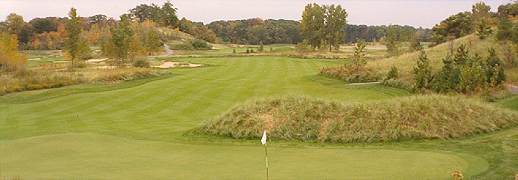
The golfer was meant to be able to play a running draw onto the right front of the 2nd green at Lost Dunes. Unfortunately, soft conditions take away that option.
22. What attracts you to new consulting jobs?
We already have a lot of clubs who count on us, and we can’t take on too many more. Basically, though, we’re attracted to the same things we are in choosing new projects — the potential of the course, and good people who will let us do our thing. For the sake of convenience, we’re also more likely to take on a new job if it’s close to home, or close to another project we have in the works.
23. What were your thoughts on playing Quail Crossing for the first time?
I thought it was great fun, and not too difficult. It reminded me of High Pointe, and of my original philosophy of golf course design — that the two most important things are a good routing and a really good set of greens. There are only 40 bunkers at Quail Crossing, to keep the budget down, but it really doesn’t need more.
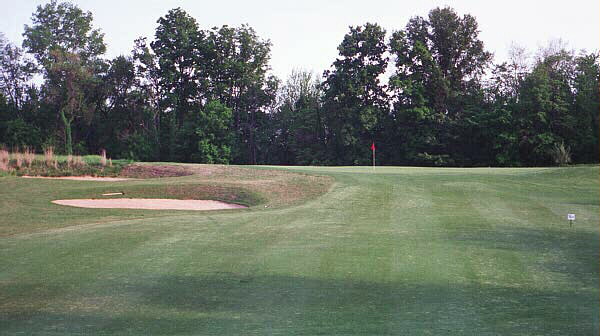
The 4th green at Quail Crossing is beautifully situated atop the crest of a hill and features an awesome green. Note the lack of any mounding or a back wall behind the green.
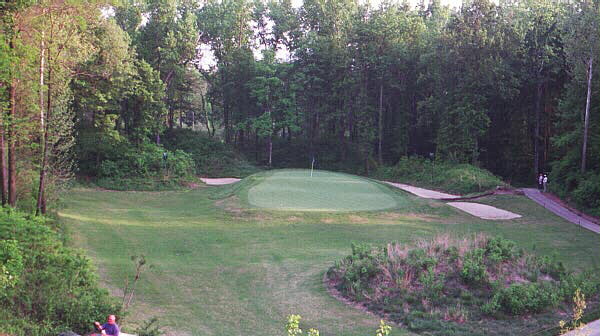
The view of the 130 yard 8th hole at Quail Crossing from its elevated tee.
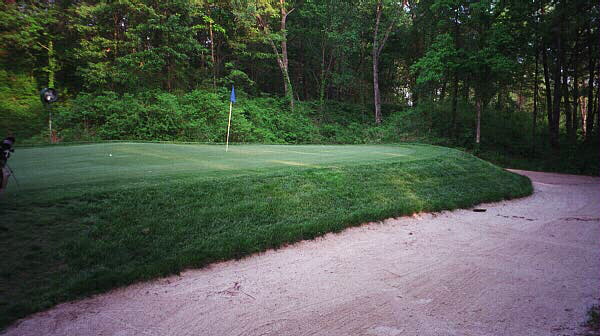
The back of the 8th green at Quail Crossing is a mere nine paces wide.
24. What is the most challenging sub 6,400 yard course that you have ever seen? What makes it so?
Rye Golf Club in England. Instead of building 500-yard par-5’s which are a pushover for good players, they made the same holes 440-yard par-4’s which just beat on the low-handicappers. Then they included a couple of extra short par-4’s to give a breather every now and then. There’s hardly ever a level lie, and the par-3’s are legendary for the trouble you’ll find if you miss a green.
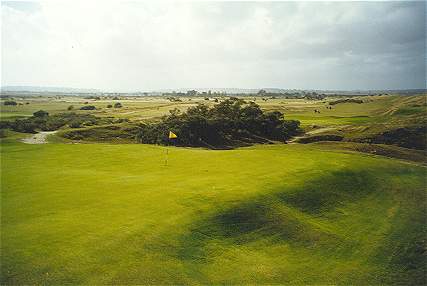
The End








